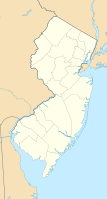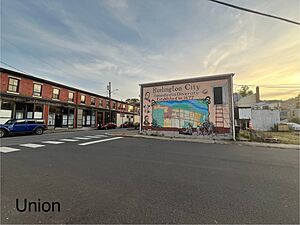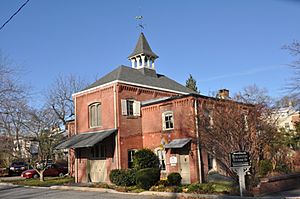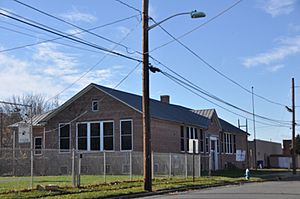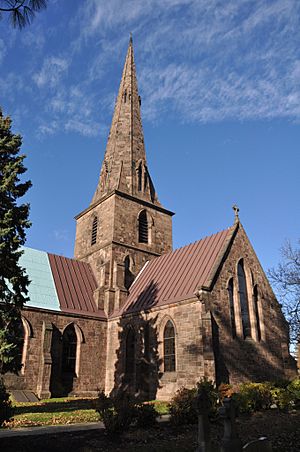Burlington, New Jersey facts for kids
Quick facts for kids
Burlington, New Jersey
|
||
|---|---|---|
|
City
|
||
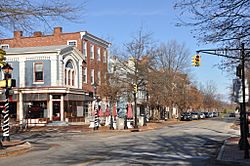
The High Street Historic District in Burlington
|
||
|
||
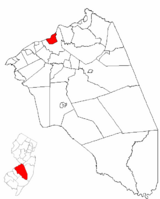
Location of Burlington in Burlington County highlighted in red (right). Inset map: Location of Burlington County in New Jersey highlighted in red (left).
|
||

Census Bureau map of Burlington, New Jersey
|
||
| Country | ||
| State | ||
| County | Burlington | |
| Formed | October 24, 1693 | |
| Royal charter | May 7, 1733 | |
| Incorporated | December 21, 1784 | |
| Reincorporated | March 14, 1851 | |
| Named for | Bridlington, England | |
| Government | ||
| • Type | Faulkner Act (mayor–council) | |
| • Body | City Council | |
| Area | ||
| • Total | 3.75 sq mi (9.72 km2) | |
| • Land | 3.04 sq mi (7.86 km2) | |
| • Water | 0.72 sq mi (1.86 km2) 19.05% | |
| Area rank | 306th of 565 in state 28th of 40 in county |
|
| Elevation | 10 ft (3 m) | |
| Population
(2020)
|
||
| • Total | 9,743 | |
| • Estimate
(2023)
|
10,024 | |
| • Rank | 251st of 565 in state 16th of 40 in county |
|
| • Density | 3,210.2/sq mi (1,239.5/km2) | |
| • Density rank | 209th of 565 in state 10th of 40 in county |
|
| Time zone | UTC−05:00 (Eastern (EST)) | |
| • Summer (DST) | UTC−04:00 (Eastern (EDT)) | |
| ZIP Code |
08016
|
|
| Area code(s) | 609 | |
| FIPS code | 3400508920 | |
| GNIS feature ID | 0885174 | |
Burlington is a city located on the Delaware River in Burlington County, New Jersey. It's like a neighbor to Philadelphia, a big city nearby. In 2020, about 9,743 people lived here. Burlington is part of a larger area that includes Philadelphia and Camden.
Burlington has a long history. It was first officially recognized as a city way back on October 24, 1693. Later, it was re-established several times, including by a special paper from the King of England in 1733. After America became independent, New Jersey officially made it a city again in 1784.
Burlington used to be the main town, or "county seat," for Burlington County. But in 1796, as more people moved east, the county seat was moved to Mount Holly Township, which was more in the middle of the county.
Contents
History of Burlington City
Early Beginnings: 1600s and 1700s
In 1676, a group of English settlers, mostly Quakers, bought land along the river from the Lenape Native Americans. They founded Burlington in 1677. For a while, Burlington was even the capital of the area known as West Jersey. This lasted until 1702, when West and East Jersey joined to become one colony.
Burlington got its name from a town in England called Bridlington. The Quakers started their church here in 1678. They first met in homes, then built a brick meeting house. The current meeting house on High Street was built in 1783. An old cemetery is there too, where a friendly Lenape chief, King Ockanickon, was buried in 1681.
One of Burlington's oldest buildings is the Revell House, built in 1685. People say that a young Benjamin Franklin once got gingerbread from this house when he was traveling. Today, a group called the Colonial Burlington Foundation takes care of it.
Growing in the 18th Century
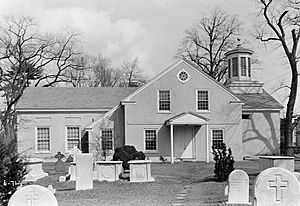
Many important places in Burlington started in the 1700s and are still around today. The second oldest church group in Burlington was the Anglicans, now called Episcopalians. Their first church, Old St. Mary's, built in 1703, is the oldest church in all of New Jersey. Later, in 1846, a new, larger St. Mary's church was built. This beautiful building is now a National Historic Landmark.
In 1838, Bishop George Washington Doane started St. Mary's, a boarding school for girls. Girls from many states came to study there, learning classical subjects, art, and music.
The Library Company of Burlington started in 1757. It was a "free" library, open to everyone. It received a special paper from King George II in 1758. The library is now in a stone building built in 1864. It's the oldest library in New Jersey that has been open continuously, and the seventh oldest in the whole country!
The Endeavor Fire Company, a fire department, was formed in 1795. It was the first permanent firefighting group in Burlington and is one of the oldest fire companies in New Jersey still using its original name.
Many famous people lived in Burlington. Captain James Lawrence, a naval hero from the War of 1812, was born here. He is famous for saying, "Don't give up the ship!" Also, James Fenimore Cooper, who wrote the famous book The Last of the Mohicans, was from Burlington.
Burlington in the 19th Century
As education became more important for girls, Bishop George Washington Doane opened St. Mary's Hall in 1837. This was the first Episcopal boarding school for girls in New Jersey. Today, it's called Doane Academy and teaches both boys and girls from pre-kindergarten to 12th grade.
The building at 301 High Street is home to New Jersey's oldest pharmacy that has been open continuously. Around 1845, a druggist named William Allinson used this building. He was also a leader in the movement to end slavery. People say that runaway slaves might have hidden in tunnels under the building as they traveled to freedom.
In the 1800s, Burlington City was known for its factories, especially shoe making. The J.F. Budd Baby Shoe Company, started in 1887, was once called the "largest baby shoe plant in the world."
The city also had a Lyceum, built in 1839, where people could go for talks, concerts, and meetings. In 1851, it became the City Hall.
The Oneida Boat Club was started in 1873 by ten friends. They built their clubhouse on the Delaware River in 1876. The Oneida is the oldest boat club still running on the Delaware River.
Burlington in the 20th Century
In the late 1960s and 1970s, Burlington made big changes to its waterfront along the Delaware River. Old factories and docks were removed. Now, there's a beautiful park with walkways along the river, where people can relax and enjoy the view. This also helps protect the city from floods.
Many historic buildings in Burlington are now protected. Besides St. Mary's Church, there are two historic areas, the Burlington Historic District and the High Street Historic District, that are listed on the National Register of Historic Places.
Burlington Coat Factory started in 1924, selling women's coats. In 1972, Monroe Milstein bought a warehouse in Burlington and started selling coats at a discount. Over time, the company grew, adding other clothes, shoes, and home items, all at low prices. Its main office moved to Burlington Township in 1988.
Geography
Burlington covers about 3.78 square miles (9.79 square kilometers). Most of this is land, with some water from the river.
Some smaller areas within Burlington include Burlington Island and East Burlington.
Burlington shares borders with Burlington Township in New Jersey. Across the Delaware River in Pennsylvania, it borders Bristol and Bristol Township.
The Burlington-Bristol Bridge connects Burlington to Bristol, Pennsylvania, across the Delaware River. It opened in 1931.
Population in Burlington
| Historical population | |||
|---|---|---|---|
| Census | Pop. | %± | |
| 1850 | 4,536 | — | |
| 1860 | 5,174 | 14.1% | |
| 1870 | 5,817 | 12.4% | |
| 1880 | 6,090 | 4.7% | |
| 1890 | 7,264 | 19.3% | |
| 1900 | 7,392 | 1.8% | |
| 1910 | 8,336 | 12.8% | |
| 1920 | 9,049 | 8.6% | |
| 1930 | 10,844 | 19.8% | |
| 1940 | 10,905 | 0.6% | |
| 1950 | 12,051 | 10.5% | |
| 1960 | 12,687 | 5.3% | |
| 1970 | 12,010 | −5.3% | |
| 1980 | 10,246 | −14.7% | |
| 1990 | 9,835 | −4.0% | |
| 2000 | 9,736 | −1.0% | |
| 2010 | 9,920 | 1.9% | |
| 2020 | 9,743 | −1.8% | |
| 2023 (est.) | 10,024 | 1.0% | |
| Population sources: 1850–2000 1850–1920 1850–1890 1850–1870 1850 1870 1880–1890 1890–1910 1850–1930 1940–2000 2000 2010 2020 |
|||
In 2010, Burlington had 9,920 people living there. The city is home to a diverse group of people from different backgrounds. The average household had about 2.5 people.
Education in Burlington
The City of Burlington Public School District serves students from pre-kindergarten all the way through twelfth grade. This district is special because the state helps pay for all school building and renovation projects.
As of the 2020-2021 school year, there were about 1,740 students and 170 teachers in the district's four schools. This means there were about 10 students for every teacher.
The schools in the district are:
- Captain James Lawrence Elementary School (Pre-K to 2nd grade)
- Samuel Smith Elementary School (Pre-K to 2nd grade)
- Wilbur Watts Intermediate School (3rd to 6th grade)
- Burlington City High School (7th to 12th grade)
Students from Edgewater Park Township also attend Burlington City High School.
Students in Burlington County can also go to the Burlington County Institute of Technology. This school offers special classes for students who want to learn job skills or technical trades. It has campuses in Medford and Westampton.
Doane Academy is a private school in Burlington. It's an Episcopal school that prepares students for college, from Pre-K through 12th grade. St. Paul Grammar School is another private school that serves students in PreK-8th grade.
Transportation
Roads and Highways
Burlington has many roads that help people get around. Major roads that go through or near Burlington include U.S. Route 130, New Jersey Route 413, County Route 541, and County Route 543. Big highways like Interstate 95, Interstate 295, and the New Jersey Turnpike are also easy to reach from Burlington.
The Burlington-Bristol Bridge is a very important bridge. It's part of Route 413 and crosses the Delaware River, connecting Burlington to Bristol Township in Pennsylvania.
Public Transportation
NJ Transit offers bus services in Burlington. You can take a bus from Burlington to Trenton or Philadelphia. There are also buses that go between Burlington and Camden.
The NJ River Line is a light rail system. It's like a train that runs between Trenton and Camden. It has stops in Burlington at Burlington South and Burlington Towne Centre.
Points of Interest
- Burlington Island: An island in the Delaware River. There are plans to create a historic amusement park here.
- Doane Academy: A private school with a long history.
- Elias Boudinot House: A historic house at 207 W. Broad Street.
- James Lawrence House: Built in 1742, this was the home of Captain James Lawrence, a hero from the War of 1812.
- James Fenimore Cooper House: The home of the famous novelist.
- Library Company of Burlington: The oldest continuously operating library in New Jersey.
- Old City Hall: A historic building that used to be the city's main office.
- Quaker Meeting House: A historic place of worship for Quakers.
- Revell House: One of Burlington's oldest buildings, built in 1685.
- St. Mary's Episcopal Church: This church has a very old original building (1703) and a newer one (1854) that is a National Historic Landmark.
- Waterfront Park and Oneida Boat Clubhouse: A park along the Delaware River and the oldest continuously operating boat club on the river.
Notable People
Many interesting people have lived in or are connected to Burlington:
- Eric Alejandro (born 1986): An athlete who runs in the 400 meters hurdles.
- Joseph Bloomfield (1753–1823): A soldier, lawyer, and governor of New Jersey.
- Elias Boudinot (1740–1821): A leader who was President of the Continental Congress.
- William Bradford (1755–1795): Fought in the American Revolution and became an attorney general.
- D'Lo Brown (born 1970): A professional wrestler.
- Cyrus Bustill (1732–1806): An African-American baker and leader who worked to end slavery.
- Isaac Collins (1746–1817): A printer who made colonial money and Bibles.
- James Fenimore Cooper (1789–1851): A famous novelist.
- Oliver Cromwell (1752–1853): An African-American soldier who fought in the American Revolutionary War.
- George Washington Doane (1799–1859): Founded St. Mary's Hall (now Doane Academy).
- William Franklin (1731–1813): The son of Benjamin Franklin and the last colonial governor of New Jersey.
- Ulysses S. Grant (1822–1885): A Union Army general and the 18th President of the United States.
- Danny Green (1876–1914): An early Major League Baseball player.
- Edward Burd Grubb Jr. (1841–1913): A Civil War General and later an ambassador.
- Ka'dar Hollman (born 1994): An NFL football player.
- Vanessa Kara (born 1996): A professional soccer player.
- James Kinsey (1731–1803): A lawyer who served in the Continental Congress.
- James Lawrence (1781–1813): A naval officer from the War of 1812, famous for his courage.
- Joseph McIlvaine (1769–1826): A United States Senator from New Jersey.
- Eddie Miksis (1926–2005): A Major League Baseball player.
- Rod Streater (born 1988): An NFL wide receiver.
- Anthony Taylor (1837–1894): Awarded the Medal of Honor for his bravery during the Civil War.
See also
 In Spanish: Burlington (Nueva Jersey) para niños
In Spanish: Burlington (Nueva Jersey) para niños




